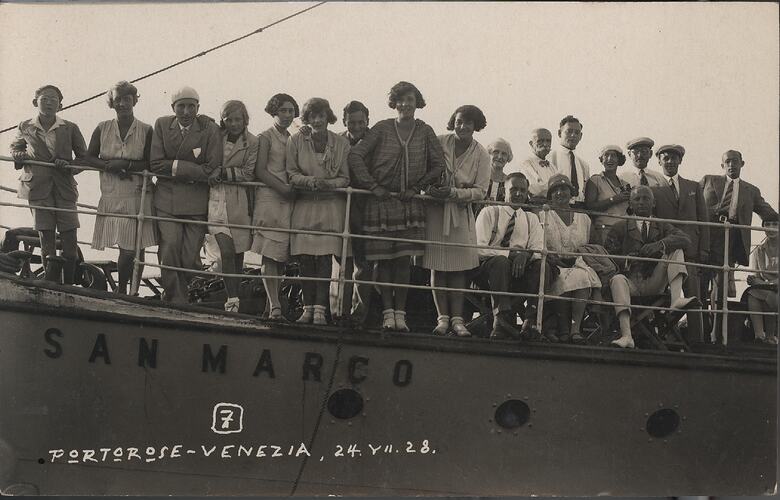Summary
Black and white photograph of Leo and Hilda Sterne, possibly with Hilda's sisters, among a group of people on the deck of the MS San Marco, off the coast of Italy, 24 November 1928.
This photograph relates to the lives of Leo and Hilda Sterne prior to their migration to Australia from Linz, Austria in 1939, joining other family members who had arrived in 1938. The Sternes (originally Sternschein), listed as 'stateless', were probably refugees accepted as part of the Australian Government's Jewish quota intake just prior to World War II. The Sterne's went on to found the successful L.J. Sterne Doll Company. Leo Sterne is recorded as having enlisted in the Citizen's Military Forces during World War II and in 1944 he was naturalised.
Description of Content
Leo and Hilda Sterne seated among a group on the deck of the MS San Marco. They are posing for a commemorative photograph for a holiday trip off the coast of Italy on 24 November 1928, possibly with Hilda's sisters.
Physical Description
Black and white photograph on paper postcard support with hand written and printed text. Round stain on reverse of photograph, left hand side.
Significance
This item is part of a growing collection of material relating to the migration and settlement experiences of Leo and Hilda Sterne who arrived in Melbourne in 1939. They immediately established a business that became one of the most successful doll and toy manufacturers in post-war Melbourne.
The L.J Sterne Doll Company (1939-71) is significant as one of the few surviving collections related to an Australian toy and doll manufacturer, a once thriving industry in Australia. Only the A.L. Lindsay and Co. Archive at the Powerhouse Museum and the Jakas Toys collection at Museum Victoria are comparable.
This collection of photographs, business and promotional documents, dolls and toys enables the exploration of many Australian post-war historical and social themes including: local television and manufacturing industries; design and production innovation; marketing and merchandising; childhood; gender and cultural representations; leisure and sport; and key cultural and historical events.
More Information
-
Collection Names
-
Collecting Areas
-
Acquisition Information
Purchase
-
Place & Date Depicted
-
Ship Depicted
-
Person Depicted
Mr Leo Sterne, Italy, 24 Nov 1928
Leo and Hilda Sterne and Hilda's sisters are possibly depicted. -
Person Depicted
Mrs Hilda Sterne, Italy, 24 Nov 1928
Leo and Hilda Sterne and Hilda's sisters are possibly depicted. -
Format
Postcard, 5½ in. x 3½ in., Black & White
-
Language
Italian
-
Inscriptions
Printed on front of photograph: '7 / PORTOROSE - VENEZIA, 24. Y11.28.' Printed text on top centre of reverse of photograph: 'CARTOLINA POSTALE / CARTE POSTALE / 'RAJAR' Hand written in pencil on right hand side of reverse of photograph: 'Portorose, Leuiren [illeg] 1928.'
-
Classification
-
Category
-
Discipline
-
Type of item
-
Image Dimensions - Photograph
133 mm (Width), 84 mm (Height)
-
Keywords
Postcards, Families, Holidaying, Ship Memorabilia, Austrian Immigration, German Immigration
